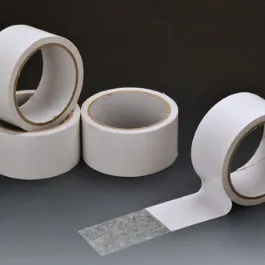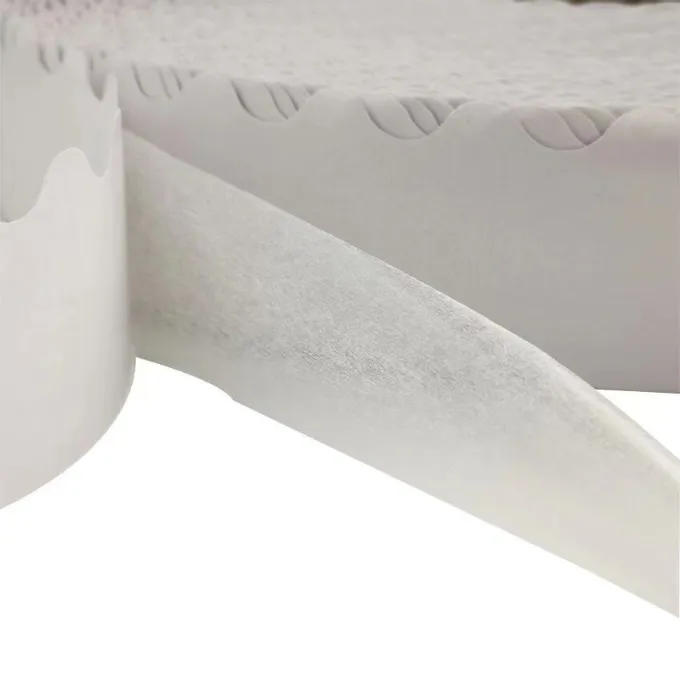
Labels and nameplates might seem like simple finishing touches, but anyone who has dealt with peeling corners or poor adhesion knows how frustrating they can be. A good bond doesn’t just make products look neat; it ensures brand durability and product identity last throughout a product’s life cycle. One often overlooked hero behind that clean, reliable finish is tissue tape, thin, adaptable, and surprisingly strong.
What Is Tissue Tape Made Of
Tissue tape is built around a lightweight tissue carrier coated with adhesive on both sides. The tissue gives flexibility and softness, allowing it to adapt to uneven or textured surfaces. The adhesive, most often acrylic, ensures long lasting hold across various materials such as plastic, paper, metal, and glass. A release liner covers the adhesive until the tape is ready to use.
Unlike film or foam based tapes, tissue tape provides a clean, almost invisible bond. It’s thin enough not to lift the label or distort a nameplate. Yet it’s strong enough to stay put even under temperature fluctuations or humidity.
Why Labels and Nameplates Need Reliable Adhesion
Labels and nameplates face more challenges than most people think. They’re constantly exposed to handling, temperature shifts, oils, and cleaning agents. When the adhesive underneath isn’t strong or compatible, bubbles appear, edges lift, and the brand’s presentation suffers.
In manufacturing environments, these issues are even more critical. Nameplates on electrical panels, machine housings, or consumer electronics must remain attached for years. Once applied, they can’t simply fall off after a few months. Replacements cost time and money.
Tissue tape offers a balanced solution: thin enough for a seamless look, strong enough for reliable bonding. It also distributes pressure evenly across the surface, minimizing weak points that could lead to peeling.
How Tissue Tape Solves Bonding Challenges
1. Strong Initial Tack
High quality tissue tapes like QKD’s acrylic based series have an initial tack ≤10mm, which means they grab fast. When pressed onto a clean surface, the bond starts instantly, helping with quick assembly and reduced production time.
2. Temperature and Humidity Resistance
In factories, products often go through temperature changes, paint curing, packaging, or even shipment through hot climates. Tapes like QKD–130CN can withstand temperatures from -20°C to 130°C or even 140°C. That’s impressive for a lightweight tape and ensures labels stay in place where ordinary adhesives might fail.
3. Versatility on Different Surfaces
Tissue tape adheres to both smooth and slightly rough surfaces, metals, coated plastics, varnished panels. The tissue carrier absorbs minor surface irregularities, maintaining uniform contact. This flexibility makes it perfect for bonding metal nameplates, paper based labels, or polymer overlays.
4. Cleaner, Neater Finish
No glue squeeze out, no messy edges. Since tissue tape has controlled thickness and adhesive coating, it delivers a professional appearance. Especially on transparent or high gloss surfaces, the difference compared to liquid glue is obvious.
Key Advantages in Label and Nameplate Bonding
Smooth Appearance
Labels stick seamlessly without bulging edges. The thinness of tissue tape keeps the surface flush and visually clean. Especially for metallic or printed nameplates, maintaining a premium look is key.
Precision Application
Die cutting is easier with tissue tape than thicker foam tapes. Factories can order pre cut rolls or custom die cut pieces to match their label shape. It helps reduce waste and improve assembly accuracy.
No Residue on Removal
In temporary labeling or quality control tags, removal without residue is crucial. Acrylic based tissue tapes are engineered for clean removal, avoiding damage to coatings or printed surfaces.
High Production Efficiency
Unlike liquid adhesives, tissue tape doesn’t require curing time. Operators just peel and stick. Combined with innovations like the wave edge liner, it cuts assembly time considerably.

Selecting the Right Tissue Tape for Your Application
Choosing the right tissue tape isn’t just about price or brand. The key factors depend on surface type, adhesive system, and environmental conditions.
1. Match Surface Texture
Smooth surfaces such as aluminum or stainless steel require medium to high tack tapes like QKD-120. Slightly rough or coated plastics may need thicker, more conformable versions.
2. Pick the Right Adhesive System
Acrylic adhesives provide stable long term adhesion and UV resistance. Rubber adhesives, while initially stronger, may yellow or weaken under heat. For outdoor or industrial labeling, acrylic is the safer bet.
3. Consider Temperature and Chemical Exposure
If labels or nameplates face heat, oil, or cleaning agents, choose a high temperature model such as QKD-130CN. Their enhanced durability keeps bonds intact even under stress.
4. Think About Process Convenience
For assembly lines where speed matters, Wave Edge Double Sided Tissue Tape is worth considering. Its design simplifies liner removal, improving overall workflow.
Industry Applications Where Tissue Tape Excels
Electronics and Appliances
Used for attaching control panel overlays, nameplates, and decorative trims. The thin profile avoids interference with buttons or displays.
Automotive
Interior nameplates, badges, and emblems often rely on double sided tissue tapes for neat finishes and long lasting adhesion.
Packaging and Printing
Tissue tapes are common in premium packaging where neat presentation is essential. They also serve as mounting aids for labels or promotional materials.
Bookbinding and Paper Arts
Its soft tissue base allows for strong yet flexible bonds in bookbinding, gift boxes, and handmade crafts.
QKD Tape’s Strength in Adhesive Solutions
QKD Tape specializes in high performance adhesive products designed for industrial and commercial needs. With a range of double sided tissue tapes and wave edge tapes, QKD focuses on balancing usability and technical reliability.
They offer custom thicknesses, die cut shapes, and adhesive types for different industry demands.By combining easy handling, strong bonding, and long term durability, QKD Tape helps manufacturers maintain cleaner production and consistent label quality without costly failures.
Conclusion
Tissue tape may look simple, but it plays a vital role in how labels and nameplates perform over time. Its thin profile, strong adhesion, and adaptability make it a go to bonding material across industries.
From electronics to packaging, and from branding to function, the right tissue tape ensures every label stays where it belongs, clean, secure, and professional. And with advanced designs like QKD’s Wave Edge Double Sided Tissue Tape, production gets faster, cleaner, and more efficient.
FAQ
Q1: What makes tissue tape better than liquid adhesive for labels?
Tissue tape offers consistent thickness, no drying time, and cleaner bonding without glue residue or mess.
Q2: Can tissue tape handle outdoor exposure?
Yes. Acrylic based tissue tapes like QKD-130CN or QKD-68606 resist UV, humidity, and temperature changes up to 140°C.
Q3: Is Wave Edge Double Sided Tape only for packaging?
While it’s popular for cartons and paper packaging, its easy peel liner also benefits labeling and assembly work.
Q4: Can tissue tape be die cut into custom shapes?
Absolutely. QKD provides die cut options suitable for different label and nameplate designs.
Q5: What’s the ideal surface preparation before applying tissue tape?
Ensure the surface is clean, dry, and free from oil or dust. A quick wipe with isopropyl alcohol often improves adhesion.
